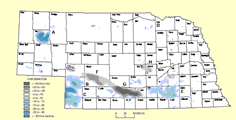Natural Resources, School of
Earthquakes in Nebraska
EC-4a
Abstract
An earthquake is the result of an adjustment of the surface of the earth caused by a release of energy in the earth's crust. Faulting is one of many causes of earthquakes. A fault or fracture normally occurs when the earth's crust bends and then breaks, forming blocks. These blocks can slip past one another either horizontally or vertically. When the movement of two blocks is nearly horizontal, the fault produced is called a strikeslip fault (fig. 1 ). When the movement of the blocks is nearly vertical, the fault produced is called a dip-slip fault (fig. 2). Along many faults the movement is in a combination of directions. Weaknesses in the earth's crust are reflected by these faults, and many earthquakes are centered in these zones of weaknesses.

